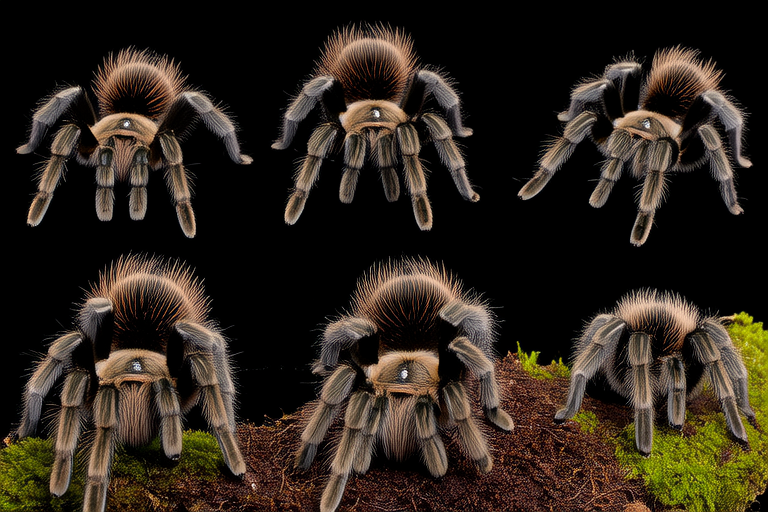Top 10 Myths Debunked About Tarantulas
Tarantulas, members of the family Theraphosidae, are among the largest spiders in the world. With over 900 known species, they exhibit remarkable diversity in size, color, and habitat. These fascinating creatures can be found across various regions, from tropical forests to deserts, showcasing a wide range of adaptations that allow them to thrive in different environments. Despite their intimidating appearance, tarantulas play crucial roles in ecosystems as predators, helping control insect populations. This article aims to dispel some common myths surrounding tarantulas, offering a more accurate and engaging perspective on these misunderstood arachnids.
Myth 1: All Tarantulas Are Highly Venomous
Debunked: While tarantulas possess venom glands, most species have venom that is relatively mild. Their bites are typically no more dangerous than a bee sting, causing localized pain, swelling, and redness. The venom primarily serves to immobilize and digest their prey, rather than posing a significant threat to humans. Only a few species, such as the Brazilian wandering spider, have venom potent enough to cause severe reactions in humans, but even then, fatalities are extremely rare.
Myth 2: Tarantulas Hunt Humans
Debunked: Tarantulas are not aggressive towards humans and rarely attack unless provoked. Their natural diet consists mainly of insects, small vertebrates, and other arthropods. They have no interest in hunting or eating humans, as we are far too large for them to consider as prey. In fact, tarantulas prefer to avoid confrontation, often retreating into burrows or hiding spots when faced with potential threats.
Myth 3: Tarantulas Are Blind
Debunked: Although tarantulas rely heavily on their sense of touch and vibrations to navigate their environment, they are not blind. Many species have eight eyes arranged in two rows on the top of their carapace. However, their vision is limited; they can detect light, shadows, and movement, but cannot form detailed images like humans. Their primary sensory organs are located on their legs, which are covered in sensitive hairs that help them feel their surroundings.
Myth 4: Tarantulas Can Spit Silk Like Other Spiders
Debunked: While tarantulas do produce silk, they do not use it to create webs like orb-weaving spiders. Instead, they utilize silk for constructing egg sacs, lining their burrows, and wrapping prey. Some species, particularly New World tarantulas, can eject urticating hairs from their abdomen as a defense mechanism against predators. These hairs are irritating to the skin and mucous membranes of potential threats, serving as an effective deterrent without the need for silk.
Myth 5: Tarantulas Have Poor Appetites
Debunked: Contrary to popular belief, tarantulas are voracious eaters. They have a high metabolism, especially during their juvenile stages, and require frequent feeding to support their growth. Adult tarantulas may go for extended periods between meals, but this does not indicate a lack of appetite. Their feeding habits are influenced by factors such as availability of prey, environmental conditions, and reproductive cycles.
Myth 6: Tarantulas Are Aggressive and Dangerous Pets
Debunked: When kept in appropriate conditions, tarantulas make relatively low-maintenance pets. Most species are docile and will only bite if severely provoked. Proper handling and care, including a suitable enclosure, temperature regulation, and a varied diet, can ensure a harmonious relationship between pet and owner. Responsible ownership requires understanding the specific needs of each species, ensuring a safe and enriching environment for both the tarantula and its human companions.
Myth 7: Tarantulas Are Always Black and Brown
Debunked: Tarantulas come in a stunning array of colors and patterns. While many species are indeed black or brown, others display vibrant hues of blue, green, purple, and even pink. These variations are especially noticeable in certain New World tarantulas, which often feature striking markings that serve as camouflage or warning signals to potential predators. The diversity in coloration underscores the adaptability of these spiders to their respective habitats.
Myth 8: Tarantulas Can Survive Without Water
Debunked: Like all living organisms, tarantulas require water to survive. They obtain moisture through their food and by drinking dew or rainwater. Some species live in arid environments where water is scarce, but they still need access to hydration. Providing a shallow water dish in their enclosures is essential for maintaining their health and well-being, especially in captivity. Dehydration can lead to serious health issues and premature death.
Myth 9: Tarantulas Are Endangered
Debunked: While some tarantula species face threats due to habitat destruction and illegal pet trade, the majority of tarantula species are not endangered. Conservation efforts, including captive breeding programs and habitat protection initiatives, contribute to the preservation of vulnerable species. It is important to support ethical practices in the pet trade and to raise awareness about the importance of protecting natural habitats to ensure the survival of these fascinating creatures.
Myth 10: Tarantulas Cannot Climb Smooth Surfaces
Debunked: Tarantulas are excellent climbers, capable of scaling smooth surfaces with ease. Their feet are equipped with tiny hairs called setae, which create friction against the surface, allowing them to grip and climb effectively. This ability is particularly useful for escaping predators and reaching new hunting grounds. Some species are even adept at swimming, further demonstrating their adaptability and resourcefulness in various environments.
Conclusion: Embracing the Fascinating Nature of Tarantulas
Tarantulas are truly remarkable creatures, rich in diversity and adaptation. By dispelling common myths and providing accurate information, we can foster a greater appreciation for these misunderstood arachnids. From their complex behaviors and vibrant appearances to their ecological roles, tarantulas offer endless fascination for those willing to look beyond the surface. Whether encountered in the wild or admired as pets, tarantulas deserve recognition for their unique contributions to our planet’s biodiversity. Let us continue to learn and respect these magnificent creatures, ensuring their place in our shared natural heritage.
